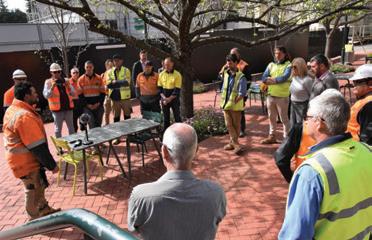
14 minute read
First Indigenous artist awarded the Archibald Prize
Vincent Namatjira, the greatgrandson of acclaimed artist Albert Namatjira, has become the first Indigenous artist to win the Archibald Prize in its 99-year history. His winning artwork, titled Stand Strong for Who You Are, is a self-portrait of Namatjira with former AFL player and 2014 Australian of the Year, Adam Goodes.
2020 marks the fourth year running the Western Arrernte artist who now lives in the APY Lands has been a finalist in the prestigious $100,000 Prize. Last year his winning streak began when he took out the Ramsey Art Prize, winning the same amount of money, and earlier this year he received an Order of Australia for his contribution to Indigenous visual arts.
Advertisement
Namatjira first met Goodes in 2018, when the footy star visited Indulkana promoting Indigenous literacy. He chose to paint him after watching his recent documentary The Final Quarter, and realising how much they had in common.
“We share some similar stories and experiences – of disconnection from culture, language and Country, and the constant pressures of being an Aboriginal man in this country. We’ve also both got young daughters and don’t want them to have to go through those same experiences,” said Namatjira.
“When I was younger and growing up in the foster system in Perth, Indigenous footballers were like heroes to me. Goodesy is much more than a great footballer though, he took a strong stand against racism and said, ‘enough is enough’. I stand strong with you too, brother.”
A message from Goodes was read when the prize was announced: “I am thrilled that an Indigenous artist, Vincent Namatjira, has won the Archibald prize for the first time, and I’m so pleased that it shines the light on all Indigenous art. We have a 60,000-year history of art and culture in our people and we share this knowledge and gift of culture with all Australia. Vincent and I are also countrymen. I’m so proud of Vincent and his family, their journey has been shared through art of generations.”
The winning artwork: Stand Strong for Who You Are by Vincent Namatjira – Archibald Prize winner 2020.
Namatjira’s win marked a record year for Indigenous talent in the Prize with other portraits by Blak Douglas, Thea Anamara Perkins and Tiger Yaltangki, and portraits of 10 Indigenous Australians lining the walls including Sydney Elder Uncle Charles ‘Chick’ Madden, rapper and writer Adam Briggs, author Bruce Pascoe and teen activist Dujuan Hoosen, known as the subject of the recent documentary, In My Blood it Runs. A few weeks earlier, Wongutha-Yamatji artist and actor Meyne Wyatt became the first Indigenous artist to win in any of the Archibald’s categories when he was awarded the Packing Room Prize for his self-portrait, Meyne. Wyatt has become well-known for both his performance on ABC’s Mystery Road, and for his monologue on racism on Q&A earlier this year.
Aboriginal bone ‘inheritors’ encouraged to contact authorities
People who are left old human remains are being urged to contact authorities after the skull of an Aboriginal woman found in the 1970s was handed into SA police by someone who ‘inherited’ it. The skull brought in to police in September was believed to have been found when West Lakes was being developed for housing in the 1970s, and has been in a family’s possession ever since.
“The man recently ‘inherited’ the skull from his father and was unsure and uneasy about what to do with it so he contacted police,” said SA Police in a statement.
They went on to say that some workers on the housing project took remains home as souvenirs.
“SAPOL and our Community Constables are working with Aboriginal Affairs and Reconciliation, Department of the Premier and Cabinet to ensure the repatriation of the remains to Country.” Forensic examination confirmed that the skull was a pre-European settlement adult female. Police urge anyone who possesses or uncovers skeletal remains to treat them with respect and contact SAPOL immediately, without disturbing the remains. This comes after members of the Kaurna community reburied remains of their ancestors uncovered during construction works for a major new road project, the Northern Connector earlier this year, and follows last year’s efforts to repatriate more than 4,500 Aboriginal remains stored in the South Australian Museum for close to 200 years.
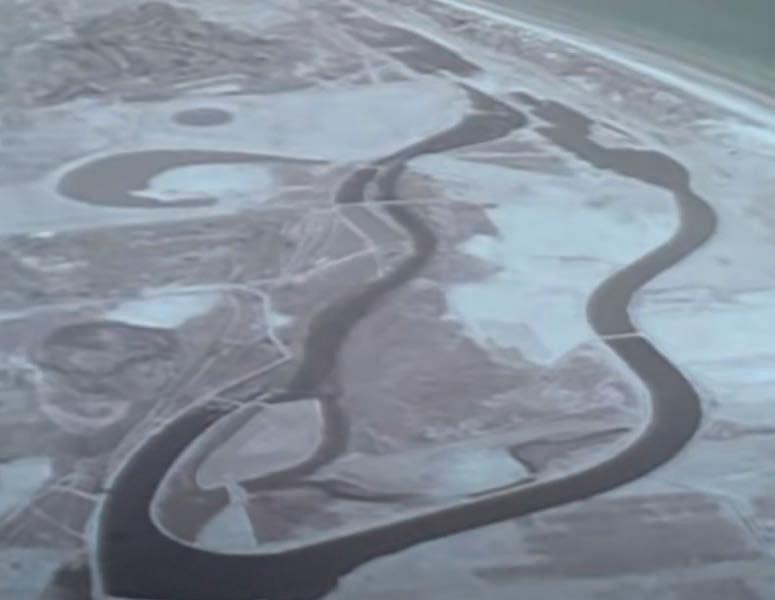
Aboriginal rangers have been employed under a Memorandum of Understanding (MOU) by the River Murray and Mallee Aboriginal Corporation (RMMAC) and the Berri Barmera Council, dedicating the land around Lake Bonney for Aboriginal cultural heritage and conservation.
The Berri Barmera Council is currently developing the foreshore as part of the Lake Bonney Nature and Cultural Tourism Project, also developed under the MOU, and the two part-time rangers are playing an important role to identify, protect and manage areas of cultural significance around the lake, a site of Aboriginal importance that is today actively promoted to tourists. Lake Bonney is a popular spot for camping, horse riding and cycling as well as water-based activities such as jet skiing, sailing, swimming, boating and fishing. The impact of visitors coming and going for these activities is taking a toll on the native flora, fauna, water and soil conditions in the area. The Council has a five-year plan underway to upgrade and preserve the area, including developing specific day sites for visitors to utilise instead of using the whole region.
The Lake Bonney Nature and Cultural Tourism Project gives RMMAC joint responsibility with the Berri Barmera Council for the care, control and management of Lake Bonney, particularly around protecting, preserving and promoting the First Nations of the River Murray and Mallee Region’s cultural heritage. “The rangers are there to protect our country and do the right thing by our ancestors so that we can pass down our knowledge to the next generation after us and the ones after that. We want to ensure our Elders can take their grandchildren down to the lake and tell them stories about the past there for generations to come. That’s really important,” said RMMAC Chairperson, Julie Cook.
“Our culture is one of the oldest cultures recorded, but it’s not just for the Aboriginal people now – today, we share this land with the wider community. Sharing our dreaming and stories helps other people understand the importance of looking after this beautiful country we are so lucky to live in here in the Riverland. “We all need to work together as one to protect it, so RMMAC placed our rangers there to do just that – to protect the land and keep our culture strong. Heidi and Bill who have been employed as the Rangers are both really enjoying it so far!” In the long-term, the Rangers will establish Aboriginal Cultural Awareness and Education programs; conduct walking tours, special events and cultural orientation as needed and manage operations around the lake.
They will also provide guidance and support for the Council for activities in and around the lake and help with natural resource management duties such as rehabilitation of areas of significance; monitoring species, habitats and ecological communities and help with weed and pests control.

Above: Lake Bonney. Images courtesy of Berri Barmara Council.
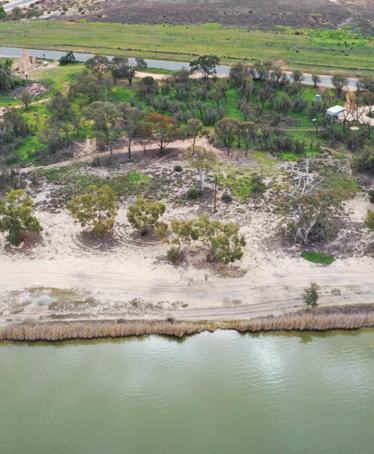
Native title claims update
We currently have 20 native title applications for determinations of native title (and one non claimant application) in South Australia. Claims update (claims listed for trial)
Walka Wani Oodnadatta No.1 and No.2 and Arabana No.2 Trial is part heard with closing submissions in March 2021.
Wirangu No.2 and Wirangu No.3 These claims are divided into Part A and Part B. Part A was listed for a consent determination in June. This has now been delayed due to the COVID-19 pandemic. Part B (an overlap with Nauo No.3) is listed for trial starting July 2021. Compliance with Court orders is ongoing. It is hoped that this area of overlap will be resolved by consent.
Nauo No.1, Nauo No.2 and Nauo No.3 State Counsel is considering material provided by the Applicant. See above also for the listing of Nauo No.3 and Nauo. Strike out by State Government and Nauo of Barngarla Southern Eyre Peninsula Claim was heard in July. Ngadjuri No.2 and Wilyakali Native title reports and supplementary reports have now been provided to the State. The overlap area (Part B) is listed for trial commencing 8 March 2021.
First Nations of the South East No.1 and No.2 and Ngarrindjeri State has positively assessed the native title reports from South East applicants. Claim likely to settle by consent. Overlap has now been listed for trial after mediation was unsuccessful. Trial commencing May 2021. Other claims
Narungga Nation Claim listed for a consent determination in June 2020 which is postponed due to the COVID-19 pandemic. Now likely to happen early next year. Nukunu and Barngarla The overlap with Barngarla in the Port Augusta region was successfully mediated with both claims amending their boundaries to remove their overlap. Both matters likely to be determined by consent. Far West Coast (FWC) Sea Claim Consent determination resolutions are ongoing.
A new exhibition has opened at Tandanya National Aboriginal Cultural Institute that takes audiences full circle from the first exhibition there in 1989, to its 30th birthday celebrations and reopening after a six and a half month temporary closure due to COVID-19 this year.
Jade Torres from Pwerle Gallery with her great grand-aunt, 97-year-old Emily Pwerle and grandmother Barbara Weir at Tandanya. Tandanya first opened its doors to the public in 1989 with an exhibition of batik artwork on silk by women from Utopia community in the NT. This year, the Gallery will be celebrating its 30th birthday (a little late, due to COVID-19) with artwork by some of the same women from the same region again gracing the walls.
Atnwengerrp – Our Apmere, Our Place presents works by four generations of artists from the small community of Atnwengerrp, 270km north-east of Alice Springs within the region of Utopia. The collection of monochromatic artwork is inspired by Country and showcases the entire community of approximately 100 people. It features work from artists such as 97-year-old Emily Pwerle, who featured in that opening exhibition at Tandanya, and her sisters. The siblings began developing expressions of their Dreamings passed down from generation to generation through painting when a painting workshop was organised for them by their niece, artist Barbara Weir, whose work also features in the show.
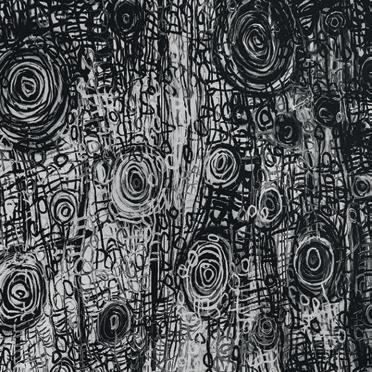
Awelye Atnwengerrp by Charmaine Pwerle.
Atnwengerrp – Our Apmere, Our Place is presented in collaboration with Pwerle Gallery, a 100% Aboriginal, family-owned company, founded in 2015 by Jade Torres, daughter of art dealer Fred Torres and granddaughter of Barbara Weir (Emily Pwerle’s niece).
Atnwengerrp – Our Apmere, Our Place runs until 21 December 2020 Tandanya open: Monday–Saturday from 10am to 5pm except Thursday 12 and Friday 13 November.
Celebrate NAIDOC Week at Tandanya
Monday 9 November: 12–2pm: Free BBQ & Acoustic Music featuring Nancy Bates 2pm: Free Weaving Workshop
Tuesday 10 November: 11am: Nunga Screen Films – Session #1 2pm: Free Cultural Dance Workshop 6.30pm: Nunga Screen Films – Session #2
Wednesday 11 November: 2pm: Free Workshop
Friday 13 November: 4–10pm: TREATY – SA’s newest First Nations music event, showcasing our best emerging and established First Nations artists. FREE community event, tickets through Moshtix required due to COVID-19 restrictions.
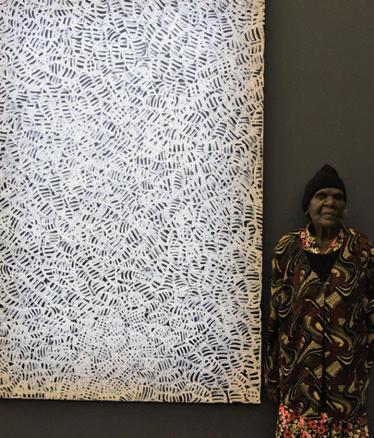
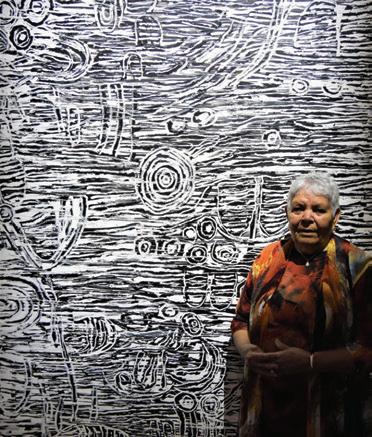

Once a fortnight at Lot Fourteen, tools are put down at 10am and construction workers file into the open courtyard or an empty room, where they hear from Aboriginal leaders, educators or anyone with a story to share. The talks are no longer than a smoko break (10 –20mins), making them easily digestible; then it’s back to work – with plenty to think about. While the former Royal Adelaide Hospital site is a hub for the wide range of entrepreneurs and the emerging future and creative industries it houses, it’s also the workplace of many construction workers and sub-contractors employed on the next big projects there, such as the Australian Space Agency, and soon the Aboriginal Arts and Cultures Centre.
Designed to build a greater understanding between Aboriginal and non-Aboriginal cultures, the Toolbox Yarns series was created specifically for construction workers and contractors, after stemming from discussions during Reconciliation Week – “why do we only talk about reconciliation and race during this week?”.
The short fortnightly sessions, a partnership between Aboriginal civil construction company RAWsa; Renewal SA’s Lot Fourteen project team and the Kaurna Nation, are open to all construction workers and subcontractors on-site, offering the opportunity to learn about Aboriginal culture and history at work.
“We’ve had people come in and talk about the repatriation process, preserving cultural heritage, but even just people talking about their experiences growing up on Country; all kinds of things,” said Shane Wanganeen, a Kaurna man who works onsite at Lot Fourteen with RAWsa to ensure cultural heritage is preserved through taking site surveys, undertaking cultural mapping, cultural heritage, repatriation and cultural awareness training.
“It’s a good way for people to get to know others onsite that they might not otherwise. It also gets awareness out about what the Kaurna people have gone through from the White Australia Policy right through to getting our native title determination on 21 March 2018. We even had the Premier Steven Marshall come to a recent session!”
Simon Jackson, who used to work onsite for Lendlease and was instrumental in setting up the program, agrees that while cultural awareness is the goal, relationship building is an important by-product.
“Honestly? I was sick of cultural awareness only at a person’s own initiative through Google; I wanted education by real people, getting to know each other through the process,” said Jackson, who’s since gone out on his own to work as a consultant in the area he’s most passionate about; creating opportunities for Aboriginal community members.
“Toolbox Yarns demystifies what can be heavy subject matter. It gives people the chance to talk through things that aren’t often discussed in our day to day. This idea could 100% be replicated on any site and in just about any industry.”
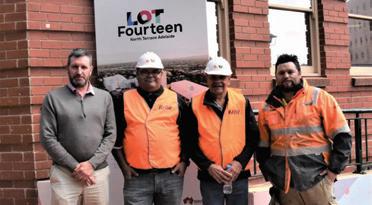
Top: Kaurna Elder Jeffrey Newchurch speaking at Toolbox Yarns. Photo courtesy of Lot Fourteen. Above: Simon Jackson, formerly of Lendlease, now independent consultant, Shane Wanganeen and Wilbur Wilson from RAWsa, and Howard Rigney from Intract Australia. Right: Howard Rigney, a young Ngarrindjeri man speaking at Toolbox Yarns. Premier Steven Marshall, who has responsibility for Aboriginal Affairs and Reconciliation, emphasised the importance of sharing stories and experiences when he spoke at Lot Fourteen’s Toolbox Yarns in early September. He said the Aboriginal Art and Cultures Centre (AACC), now being planned for Lot Fourteen in close partnership with Aboriginal people, would make a major contribution to reconciliation.
“Some people come to reconciliation very quickly, some people take a long period of time, but the more that we can share stories and share experiences, the better off we will be, so that Aboriginal people can understand our perspective and we can understand their perspective and we can work together on this journey of healing and reconciliation.
“We have an opportunity to do something that is globally significant. It will be very important in the reconciliation that we have with Aboriginal people.
“Art itself is a wonderful expression of culture that can be used to preserve stories and songlines, but it’s also a great celebration of that culture for the rest of the world. That’s one of the motivating factors for me for Lot Fourteen and what we want to establish here with the AACC.
“When I speak to Aboriginal people, they are very proud of their culture, they are very proud of 65,000 years on this continent, nurturing this continent, looking after this land. When you read some of the history of things that happened before colonisation, you do learn a lot more about the wonderful communities and nations that existed here before. What I hope, with the AACC, we can start to celebrate that 65,000 years of Aboriginal stories and songlines.
“I don’t want it to be a gallery which is just ethnographic, with grainy black and white photos of what has happened over time. I think it’s got to be something which celebrates what has happened in the past, recognises that it hasn’t always been good, in fact it’s actually been very brutal and there has got to be a strong element of truth telling in this gallery.
“I hope that you see that what you’re doing in transforming the old Royal Adelaide Hospital site into its new purpose that you are all participating in a very important process of reconciliation for our State, so I just want to say thank you very much for that.
“Hopefully you will get a great sense of pride as this incredible site rolls out over the years and you will be able to say to your kids and your family members as you’re driving past, I was involved in that fantastic transformation,” said Mr Marshall
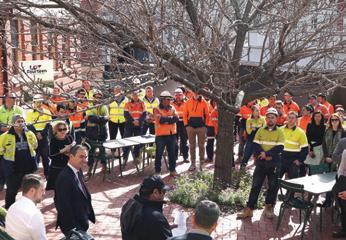
Toolbox Yarns at Lot Fourteen with Premier Steven Marshall. Photo courtesy of Lot Fourteen.
